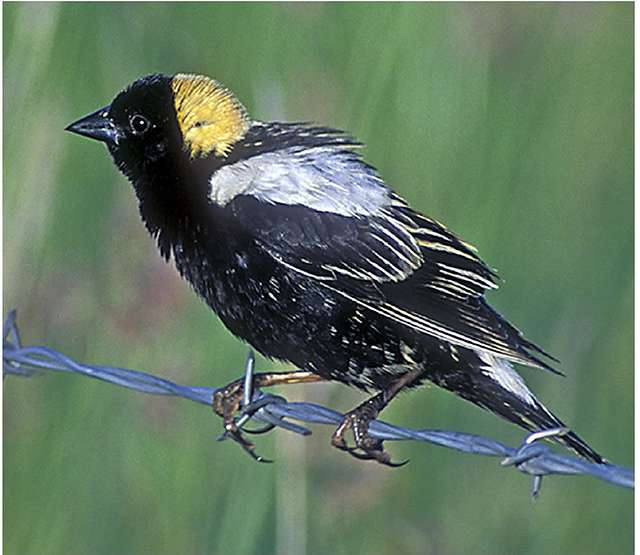SCORES & OUTDOORS: The advantages of having Bobolinks around
 by Roland D. Hallee
by Roland D. Hallee
A couple of weeks ago a friend asked me about the songbird, Bobolink, and are there any in Maine. Well, bobolinks and other grassland birds are true agricultural allies to central Maine farmers – they eat large quantities of insects that damage crops.
The Bobolink is one of the world’s most impressive songbird migrants, traveling some 12,500 miles to and from southern South America every year. Throughout its lifetime, it may travel the equivalent of four or five times around the circumference of the earth.
The species name of the Bobolink means “rice eating” and refers to this bird’s appetite for rice and other grains, especially during migration and in winter.
A migrating Bobolink can orient itself with the earth’s magnetic field, thanks to iron oxide in bristles of its nasal cavity and in tissues around the olfactory bulb and nerve. Bobolinks also use the starry night sky to guide their travels.
The strange common name is frequently traced back to a 19th century poem by William Cullen Bryant in which he refers to the bird as “Robert of Lincoln.” The name comes both from the Bobolink’s “reverse-tuxedo” pattern of mostly black with a white back, as well as 19th century English speakers’ insistence they heard the name within the bird’s song, not something that is easy to do. That mouthful was eventually shortened to “Bob of Lincoln”, and then again to “Bob o’ Linc”, giving us the bird’s modern name. They were also often called “ricebirds” thanks to their propensity to consume and live near the crop, which provided an excellent addition to their typical diet that includes a heavy dose of grass seeds.
Today, Bobolinks can still be found near farmland provided it includes unkempt edges for nesting, but their preferred habitat is in the pockets of native grassland.
Perched on a grass stem or displaying in flight over a field, breeding male Bobolinks are striking. No other North American bird has a white back and black underparts (some have described this look as wearing a tuxedo backwards). Added to this are the male’s rich, straw-colored patch on the head and his bubbling, virtuosic song. As summer ends he molts into a buff and brown female-like plumage. Though they’re still fairly common in grasslands, Bobolink numbers are declining.
It’s easiest to find Bobolinks if you look for males giving their display flights during spring and early summer. In grassy or overgrown fields and pastures, listen for a long, burbling song punctuated with sharp metallic notes. The male Bobolink often sings this song while flying in a peculiar helicopter-like pattern, moving slowly with his wings fluttering rapidly. Outside of the breeding season, look for these in rice fields and listen for their sharp pink call notes.
If there’s breeding habitat of grassy pasture or overgrown fields near your home, Bobolinks may visit open yards to forage on seed-bearing weeds.
Bobolink molt twice a year, completely changing all their feathers on both the breeding and wintering grounds. When the male grows new feathers on the wintering grounds they all have yellowish tips, so he still looks like a nonbreeding bird. Eventually the pale tips wear off to reveal his striking black-and-white breeding colors.
Normally a daylight forager, the Bobolink sometimes feeds after dark on bright nights during migration, to build fat reserves for its long flight over the Gulf of Mexico.
Bobolinks are related to blackbirds, which are often polygynous, meaning that males may have several mates per breeding season. Bobolinks are polygynous, too – but they’re also often polyandrous: each clutch of eggs laid by a single female may have multiple fathers.
The oldest Bobolink on record was a female known to be at least nine years old.
The Bobolink was immortalized by nineteenth-century American poet William Cullen Bryant, in a poem titled Robert of Lincoln. The poem recounts the events of “Bob-o-‘Link’s” nesting season, describing the male’s flashy coat and song, the female’s modest attire and subdued voice, and the six purple-flecked eggs that hatch into nestlings.
Roland’s trivia question of the week:
Who is the only defenseman in NHL history to lead the league in scoring? Hint: He did it twice.
Responsible journalism is hard work!
It is also expensive!
If you enjoy reading The Town Line and the good news we bring you each week, would you consider a donation to help us continue the work we’re doing?
The Town Line is a 501(c)(3) nonprofit private foundation, and all donations are tax deductible under the Internal Revenue Service code.
To help, please visit our online donation page or mail a check payable to The Town Line, PO Box 89, South China, ME 04358. Your contribution is appreciated!



Leave a Reply
Want to join the discussion?Feel free to contribute!